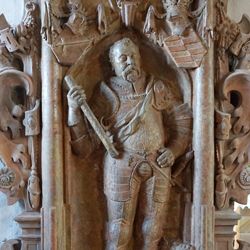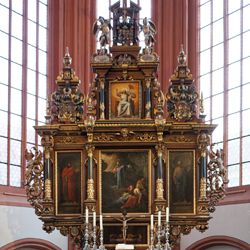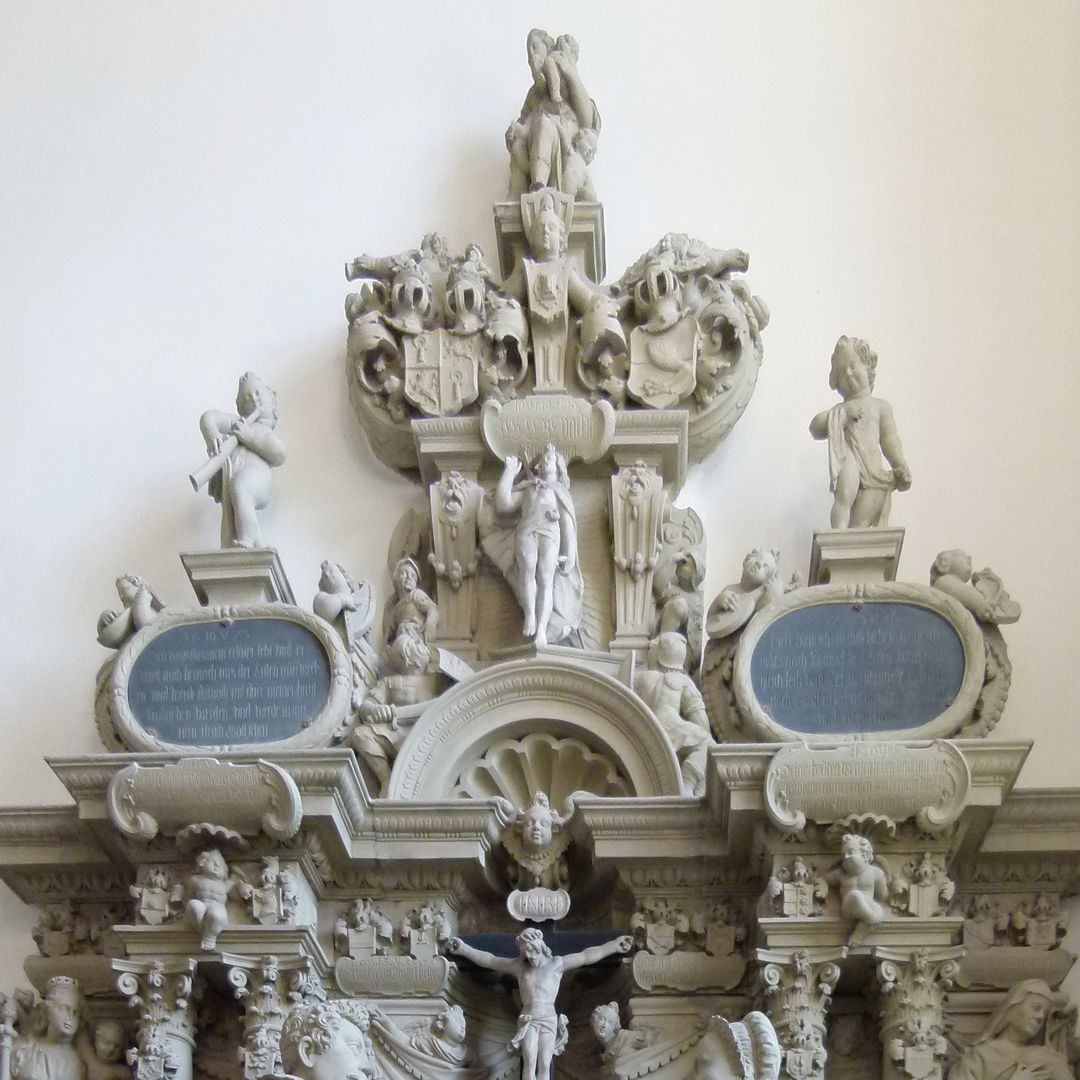Hans
Werner
sculptor
born Mechenried bei Haßfurt, 1560
buried Nürnberg, 13. Sep 1623
∞ Margaretha (buried 27.2.1617), one daughter surviving. Can be traced for the first time in Schweinfurt in 1586.
His artistic career began in 1588 in Bamberg, where he worked for the prince-bishop's court, among others. In 1596/97 he received 10 fl. for the creation of a coat of arms for the newly built Neunkirchner Hof in Nuremberg (formerly Tetzelgasse 20, north of the Peststadel), which from then on served as accommodation for the Bamberg envoys in Nuremberg. After the Counter-Reformation, Werner left Bamberg for reasons of faith and settled in Nuremberg in 1600. He first lived in Kothgasse (today's Brunnengasse), then in Grasersgasse in 1617. From Nuremberg he also completed orders from Württemberg, Coburg, Bayreuth and Kulmbach. For Martin Peller he supplied four elaborately designed fireplaces for the front house and made for him a carved grille for a furnace niche for his "Beautiful Room". In 1616 he worked on the tomb of Wilhelm von Streitberg and his wife Anna in the parish church at Ahorn near Coburg. His daughter Anna Maria married the sculptor Veit Dümpel.
"In Werner's works, the early baroqueization of the Renaissance takes place. Initially bound to the architectural framework and ornament, Werner developed into a master with a strong expression of personality, creating from the full, who is a virtuoso in ornament and in figural sculpture masters the human figure and its portrait-like individual development. In the struggle of the time for a new form of expression, Werner is a lone fighter far ahead of the Baroque, who rises to achievements of general renown in works such as the funeral monument of Bishop Ernst von Mengersdorf in Bamberg, the Streitberg monument in Ahorn, the armory portal of the Plassenburg. In his putti and frequently applied self-portraits he develops a surprising agility and naturalness. He is an independent master who makes the designs and models for his works himself. Only for the epitaph of Bishop Ernst von Mengersdorf did he have a design (sketch) by Jakob Ziegler the Elder. With preference he used fine-grained sandstone, then also alabaster, marble and limestone. He was also skilled in wood carving. He draws with full name or with the letters H.W., which also occur connected."
(Fritz Traugott Schulz / Thieme-Becker)
Works:
AHORN b. Coburg:
- ev. Pfarrkirche: magnificent tomb of Wilhelm von Streitberg and his first wife Anna (together with Veit Dümpel).
NÜRNBERG,
- Johanniskirche: Tomb of Friedrich von Dobschütz, 1601
- Kraftshof Parish Church: Tomb of Hieronymus Kreß
Wöhrdertorastei: three coats of arms, paid in October 1613 with 143 florins
- Tucherschloss in Hirschelgasse: chimney
- Portal with oxen on the Fleischbrücke, 1599
- Meat bridge: Fleischhauerbrunnen (attributed, copy, original in GNM).
MuS: NÜRNBERG, GNM: alabaster sculpture on the splendor bed of the Scheurl family (together with Veit Dümpel).
Lit.: ADB; Thieme-Becker; Nagler, Monogr. III, 1703; Th. Hampe, in: GNM M, 1909; Herold, 1917;
F. Ettinghausen: Hans Werner, Diss. Würzburg 1921; Sitzmann, 1983, pp. 572-575;
E. Masa, Freiplastiken; Büchner, 1995; Stadtlexikon 2000
(quoted from the Nuremberg Künstlerlexikon, edited by Manfred H. Grieb)
__________________
Additions from Dehio (author Tilmann Breuer):
BAMBERG:
- St. Michael, epitaph for Prince-Bishop Veit II of Würzburg ( † 1577), late mannerist beklemmt, but of elaborate ornamentation, 1580 by H.W.
- St. Michael, By the same hand more modest, somewhat freer the sandstone epitaph for Prince-Bishop Joh. Georg Zobel of Giebelstadt († 1580).
- St. Michael, demonstrably by Werner 1595/96 the epitaph for Prince-Bishop Ernst von Mengersdorf († 1581), admittedly after a sighting by the court painter Jakob Ziegler. The epitaph shows above the deceased the construction of the temple, in which the boy Jesus instructs the scribes, as an indication of the bishop's services to the clerical seminary.
- Geyerswörth, in 1587 the coat of arms of Prince-Bishop Ernst von Mengersdorf above the main gate, attributed to Hans Werner
- Habergasse 11, building with ornamental half-timbering from 1582, a house sign in relief in sandstone - elephant - perhaps by Hans Werner
BAYREUTH:
- Hl. Dreifaltigkeit, high altar, dated 1615, donation of Margravine Maria; design and execution by Hans Werner, collaborator Veit Dümpel. Three-axis wooden construction with rich carved decoration of cartilage and fittings; lateral completion by founder's coat of arms between ornamental obelisks, at the extension pelican and coat of arms with Passion insignia, flanked by angels and crowned by the Crucified; charming side cheeks.
- Holy Trinity, In the neo-Gothic font eight quality alabaster reliefs (from the original font), the scenes drawn on the sacrament of baptism, 1615 by Hans Werner.
CADOLZBURG:
- Evangelical parish church, in the sacristy marble tomb slab for Pastor Petrus († 1488) with full-length relief depiction, and sandstone epitaph for Georg von Giech († 1600) by Hans Werner.
FORCHHEIM:
- Cath. parish church St. Martin, epitaph of Georg Groß-Pfelder (†1549).
GÖßWEINSTEIN:
- Cath. parish and pilgrimage church of the Most Holy Trinity, outside on the eastern front Mengersdorf epitaph, inscribed 1588 Hans Werner, sculptor from Bamberg.
HENFENFELD:
- St. Nicholas Lutheran Parish Church, exterior between tower and chancel Pfinzing monument; above recumbent tombstone in relief interesting massive columned canopy 1613 by Hans Werner.
- KIRCHEHRENBACH:
- Catholic parish church of St. Bartholomew, two funerary monuments 1593 and 1594, one inscribed to Hans Werner, the other attributed to him, probably both workshop work.
KULMBACH:
- Hochschloss, on the west front sandstone statue of a Roman warrior c. 1600/10 inscribed H.W.
- Niederschloss, Christian tower probably after a general design by Werner 1607
- Barracks building, cellar gate, above it Bacchus by Hans Werner around 1605
- Commandant's house, in the courtyard antique sandstone figures, inscribed H.W.
MÜHLHAUSEN ( district Erlangen-Höchstadt):
- Cemetery, fragment of the tomb for a marshal von Ebnet 1613
POMMERSFELDEN:
- Ev. parish church, family epitaph for Christoph Truchsess von Pommersfelden († 1565)
SCHWEINFURT:
- Ev. Stadtpfarrkirche St. Johannis, epitaph for Wolf Christoph von Steinau, dated 1588 H(ans) W(erner).
- Town Hall, in the ground floor hall cross fragment, translocated from the abandoned Old Cemetery.
UNTERLEITERBACH:
- Catholic Filial Church of St. Maria Magdalena, funerary monument for the family of Joh. Ludwig von Schaumberg,
Style: Renaissance, Late Renaissance



